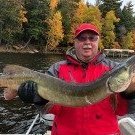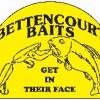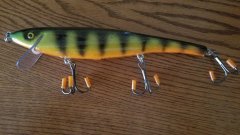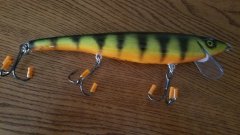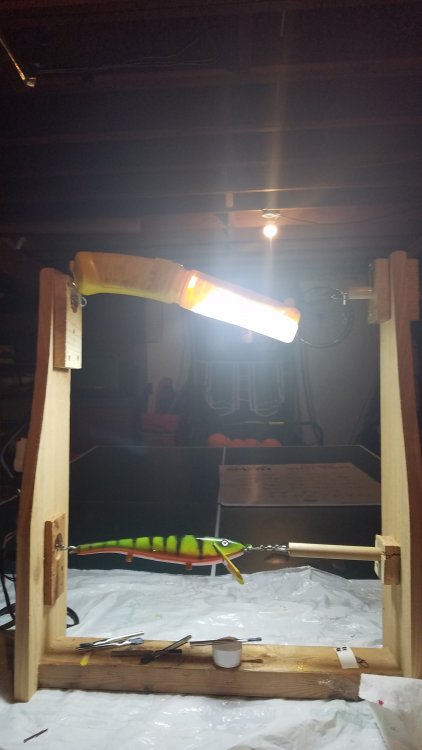-
Posts
71 -
Joined
-
Last visited
About Toadman
- Birthday 11/11/1949
Profile Information
-
Location
Wisconsin
-
Interests
Muskie Fishing, Bow Hunting Whitetails, Boating & Camping with an occasional beverage of choice.
Contact Methods
-
Yahoo
pthomann@frontier.com
Recent Profile Visitors
1,257 profile views
Toadman's Achievements
-
Yes, I have (3) of these in my Lakeland Box and they still use the same technique. It would only fail if the entire lure self destructed from the inside/out. Added bonus, they are ugly, but catch fish!
-
Very well put, you were well on your way to convincing me, now you have. Thanks and may you and I be recipients of those "Once in a Lifetime Moments" this coming year! Also, for whatever it's worth, I have a friend and fellow lure maker who also makes Muskie Baits. He uses what I thought to be an interesting approach by using stainless steel cotter pins. He drills a hole through the entire bait (top to bottom) and inserts the pin, making a channel on top for the "legs" to be bent into, and fills in with wood filler and goes on. Of course, that still leaves the front/rear hook hangers where he is using "screw-in" eyes. He is an avid Muskie Fisherman and has caught many, many big fish without any issues. I believe what we are all saying here is that no matter which system we use for "certainty", the system is only as good as all of the parts combined. The Engineered Anglers approach to these tests say as much. Given the Person, Reel, Rod, Line, Leader, Hook Eye, Swivel, Split-Rings, Hooks & Fish, it seems likely that at least (1) of these will eventually fail. Of course none of us want that failure to be because of something we did, however likely it seems that it will do so. This probably points more towards checking the entire system more often then what we do. How often do we scrupulously check all of these factors within our systems? More often than not, we just grab another lure, put it on our line and get back to casting for the "Big One". Keep on Fishing for those elusive "Big Ones" and of course remember the old saying of "The Big One that got away"!
-
HAGENSFISH.COM sells 1-7/16" - .;092" SS screw eyes for around $.22 each. They also have about everything else you will need for any type of lure making. https://hagensfish.com/
-
I think that as long as they make a ton of commotion, noise and waves, you are on to something. It's really about being in the right place at the right time anyway. In my mind, the main purpose of a top-water bait is to get the attention of critters below under the water. It represents an injured fish, bird or animal, not sure which, not sure it matters if the fish are curious and more importantly, hungry. I say give it a shot!
-
Toadman started following mark poulson
-
Hi Mark, Thanks again for your very detailed step-by-step description of the production of this lure. Everything is pretty straightforward except the tail portion and the amount of curl and the shaping of same. From what I gather in reading your description, this is the most critical part of the entire process. Also, it would seem that at least a portion of this is simply trial and error, which accounts for leaving more material than you will probably ultimately need and reducing it as you test. The idea of using lead wire and adjusting as you go along is also unique. I am very much impressed and this will be one of my future projects. You say you aren't an artist? I would say you truly are one. Have you ever considered doing a video of this process, like Marling Baits and others? You are a true inspiration to myself and many others I'm sure. One great thing about living in Wisconsin is we have long winters which allows plenty of time to do this kind of stuff. I will keep you posted on my progress. Thanks again Mark!
-
I am in awe, this is made from composite decking material? Also, how did you make the tail?? There is a YouTube video of something similar, but not quite like this. I really want to make one of these in the larger 7-1/2" or larger variety for Muskies. Maybe we could talk details??
-
Thanks again, maybe you could send or post pics??
-
Thanks for the great info Mark. I believe I will give it a try on my next go around. Also intrigued by the Whopper Plopper design and will be attempting that. Thanks Hillbilly Voodoo as well. This is a really great forum with a wealth of info.
-
I am not familiar with using decking material like this. I have been intrigued by other comments using this stuff. I have only been making lures for about 1-yr and have only used Cedar up until now. Is this stuff the same as using wood? Weight, density, holding power, carving the same? Thanks for your input!
-
I have not used a Whopper Plopper, but I am fascinated by the design and hope to "re-create" my own version soon. It looks pretty straightforward with having the joint towards the back 1/3 of the bait. The challenge will be to come up with the appropriate shape to the tail version (rubber or plastic) to allow for proper rotation and action. Stay tuned, I will keep you posted on my results! One more story with regards to top water lures: I began serious fishing with a good friend while in Northern Wisconsin. His father gave us each a classic Injured Minnow. My buddy who had considerable prior experience was with me on the first evening about 2-hrs before dark. As we were approaching what looked like a good area to fish, a nice 4-5 lbs bass broke the surface near us. My buddy immediately stopped the boat and cast to the spot. As luck would have it, he managed to cast on the exact spot where the fish had broken the surface. In a split second, the fish was on the lure like stink on sh_t. He brought the fish to the net and I was "hooked" for life on top-water fishing. The shear action and terrifying crash of a big fish breaking the surface is all that it took for me. This of course only works when conditions are right and fish are actively feeding on the surface. I have zillions of lures as do most fishermen, but I have a special affinity for top-water because of this one instance and I have had many, many others in my old life!
-
I fished a very similar spot in Canada in one of the shallow bays on Lake Nipigon in Ontario. It was so shallow, you could literally pick out the large northerns laying in the water like logs and cast to them. They were there to spawn and would head out into the main lake after spawning. We caught fish all day long with the largest being around 22lbs. GREAT memories. You either had to go with a shallow spoon like a daredevil or a topwater because the water was no more than 3' deep.
-
If you look at the wide variety of style, size, color and type of Musky & Pike baits used today, some of them defy description. Many of the rubber and plastic baits are super heavy and require stiff, long 7-9' heavy action rods, but they do work effectively. In my humble opinion a GREAT deal of the results are hinged upon being in the right place at the right time and considerable luck coupled with knowledge of the body of water, the area and prior experience. That's why it's called fishing I guess and not catching. I fished our local tournament for 2-years without success and for the past 2-years have had great success. I might go another 2-years or more without success, but I will keep trying. In any case, fishing for Musky and Pike with top water baits has it's time and place, but when they work, they certainly are violent, head shaking experiences that will create memories lasting a lifetime.
-
I built a small turner using scrap lumber and two 120volt motors I bought from ebay for about $10. I can do (4) lures at a time with this device, which for my operation works fine. The lures rotate at around 4rpm and I brush the epoxy on as they are turning. I use eTex Lite and allow 24hrs for each coat.



